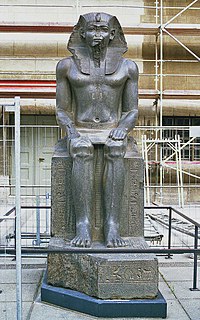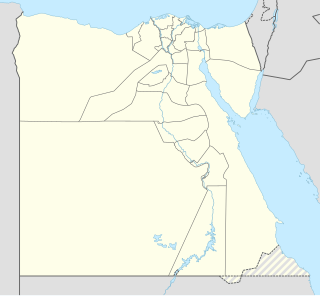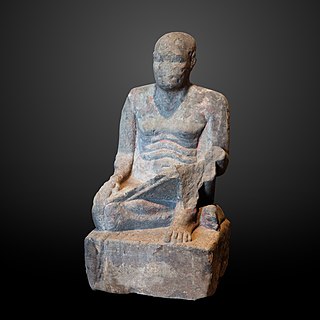
Amenemhat III, also spelled Amenemhet III, was a pharaoh of the Twelfth Dynasty of Egypt. He ruled from c. 1860 BC to c. 1814 BC, the highest known date being found in a papyrus dated to Regnal Year 46, I Akhet 22 of his rule. His reign is regarded as the golden age of the Middle Kingdom. He may have had a long coregency with his father, Senusret III.

The Middle Kingdom of Egypt is the period in the history of ancient Egypt following a period of political division known as the First Intermediate Period. The Middle Kingdom lasted from around 2050 BC to around 1710 BC, stretching from the reunification of Egypt under the reign of Mentuhotep II of the Eleventh Dynasty to the end of the Twelfth Dynasty. The Eleventh Dynasty ruled from Thebes and the Twelfth Dynasty ruled from el-Lisht. Some scholars also include the Thirteenth Dynasty of Egypt wholly into this period as well, in which case the Middle Kingdom would finish around 1650, while others only include it until Merneferre Ay around 1700 BC, last king of this dynasty to be attested in both Upper and Lower Egypt. During the Middle Kingdom period, Osiris became the most important deity in popular religion. The Middle Kingdom was followed by the Second Intermediate Period of Egypt, another period of division that involved foreign invasions of the country by the Hyksos of West Asia.
Teti, less commonly known as Othoes, sometimes also Tata, Atat, or Athath in outdated sources, was the first pharaoh of the Sixth dynasty of Egypt. He is buried at Saqqara. The exact length of his reign has been destroyed on the Turin King List but is believed to have been about 12 years.

Amenemhat I, also Amenemhet I and the hellenized form Ammenemes, was the first ruler of the Twelfth Dynasty, the dynasty considered to be the golden-age of the Middle Kingdom of Egypt. He ruled from 1991 BC to 1962 BC.

Nubkaure Amenemhat II was the third pharaoh of the 12th Dynasty of Ancient Egypt. Although he ruled for at least 35 years, his reign is rather obscure, as well as his family relationships.

Khakheperre Senusret II was the fourth pharaoh of the Twelfth Dynasty of Egypt. He ruled from 1897 BC to 1878 BC. His pyramid was constructed at El-Lahun. Senusret II took a great deal of interest in the Faiyum oasis region and began work on an extensive irrigation system from Bahr Yussef through to Lake Moeris through the construction of a dike at El-Lahun and the addition of a network of drainage canals. The purpose of his project was to increase the amount of cultivable land in that area. The importance of this project is emphasized by Senusret II's decision to move the royal necropolis from Dahshur to El-Lahun where he built his pyramid. This location would remain the political capital for the 12th and 13th Dynasties of Egypt. The king also established the first known workers' quarter in the nearby town of Senusrethotep (Kahun).

Lisht or el-Lisht is an Egyptian village located south of Cairo. It is the site of Middle Kingdom royal and elite burials, including two pyramids built by Amenemhat I and Senusret I. The two main pyramids were surrounded by smaller pyramids of members of the royal family, and many mastaba tombs of high officials and their family members. They were constructed throughout the Twelfth and Thirteenth Dynasties. The site is also known for the tomb of Senebtisi, found undisturbed and from which a set of jewelry has been recovered. The pyramid complex of Senusret I is the best preserved from this period. The coffins in the tomb of Sesenebnef present the earliest versions of the Book of the Dead.

The Ancient Egyptian noble Intefiqer(ỉnỉ-ỉt.f ỉqr) was overseer of the city and Vizier under Amenemhet I and Senusret I during the early 12th Dynasty. He is known from several rock inscriptions in Lower Nubia, showing that he was part of a military mission into this region. He appears in an inscription found at the Red Sea coast and in the so-called Reisner Papyri. Two rock inscriptions in Lower Nubia mention him. They seem to indicate that he was involved in a military campaign into this region. The inscriptions are not dated, but other inscriptions in the region seem to indicate a military campaign in year 29 of Amenemhet I, which corresponds to the 9th year of Senusret I. Intefiqer is also known from a stela found at Wadi el-Hudi, dated to year 20. It reports the bringing of Amethyst.

The Pyramid of Amenemhet I is an Egyptian burial structure built at Lisht by the founder of the Twelfth Dynasty of Egypt, Amenemhet I.

Khnumhotep III was an Ancient Egyptian high steward and vizier of the 12th Dynasty.
The Treasurer in Ancient Egypt is the modern translation of the title imi-r ḫtmt. The office is known since the end of the Old Kingdom, where people with this title appear sporadically in the organization of private estates.

Mentuhotep was an Ancient Egyptian official and treasurer under the 12th dynasty pharaoh Senusret I. Mentuhotep is one of the best attested officials of the Middle Kingdom period. There is a series of statues found at Karnak, showing him as a scribe. On these he has been given the title of overseer of all royal works, which would suggest that he was involved in overseeing the construction of the temple at Karnak. At el-Lisht he had a large tomb next to the pyramid of Senusret I. When it was found it was badly damaged, but there are remains of high quality reliefs and fragments of statues. The burial chamber still contained two sarcophagi, one smashed and the other one well preserved, made of granite and with brightly painted interiors.

Rehuerdjersen was an Ancient Egyptian treasurer who held this office under the 12th Dynasty pharaoh Amenemhat I.

Siese was a vizier and treasurer of the Twelfth Dynasty of Egypt. He was most likely in office under Amenemhat II.
Sobekemhat was an Ancient Egyptian treasurer under the king Senusret III in the Twelfth Dynasty. Sobekemhat is only known from his mastaba excavated in 1894 next to the pyramid of Senusret III at Dahshur. The mastaba was decorated on the outside with reliefs. These were only found in small fragments, but the fragments record the name and the titles of Sobekemhat. On an offering table he bears the title of the treasurer. The mastaba is in a chain of three mastabas, north of the king's pyramid. It is closest to the pyramid. The next mastaba belongs to the vizier (Nebit) and the third to another high official, perhaps again a vizier. Therefore, it can be argued that Sobekemhat's tomb was the earliest of the three. For a long time it was thought that Sobekemhat was vizier, but the relief fragments with the vizier's title come from the mastaba of Nebit nearby.

Senewosret-Ankh was High Priest of Ptah in Memphis, Royal Sculptor, and Builder likely during the time of Senusret I of the 12th Dynasty.
Nebit was an Ancient Egyptian official during the reign of king Senusret III. He held the position of vizier. Thus he was the most important official at the royal court. Nebit is only known from his large mastaba which was excavated next to the pyramid of the king at Dahshur. The mastaba was built of mud bricks and then covered with stones. Already in ancient times the high quality stone was looted and used for other building projects or just for burning lime. However, one wall of the mastaba facade had already collapsed and had been covered by sand before looters dismantled the rest of the building. The preserved facade bears the name and title of Nebit, but also the name of the king. Within the remains of the mastaba were found by Jacques de Morgan the bust of a statue made of granodiorite. The fragment is unscribed but most likely depicts Nebit.
Nakht was an Ancient Egyptian official living around 1950 BC under king Senusret I in the Twelfth Dynasty. His main title was high steward. As high steward he was responsible for the domains providing the palace and the royal residence with food and other resources.


















